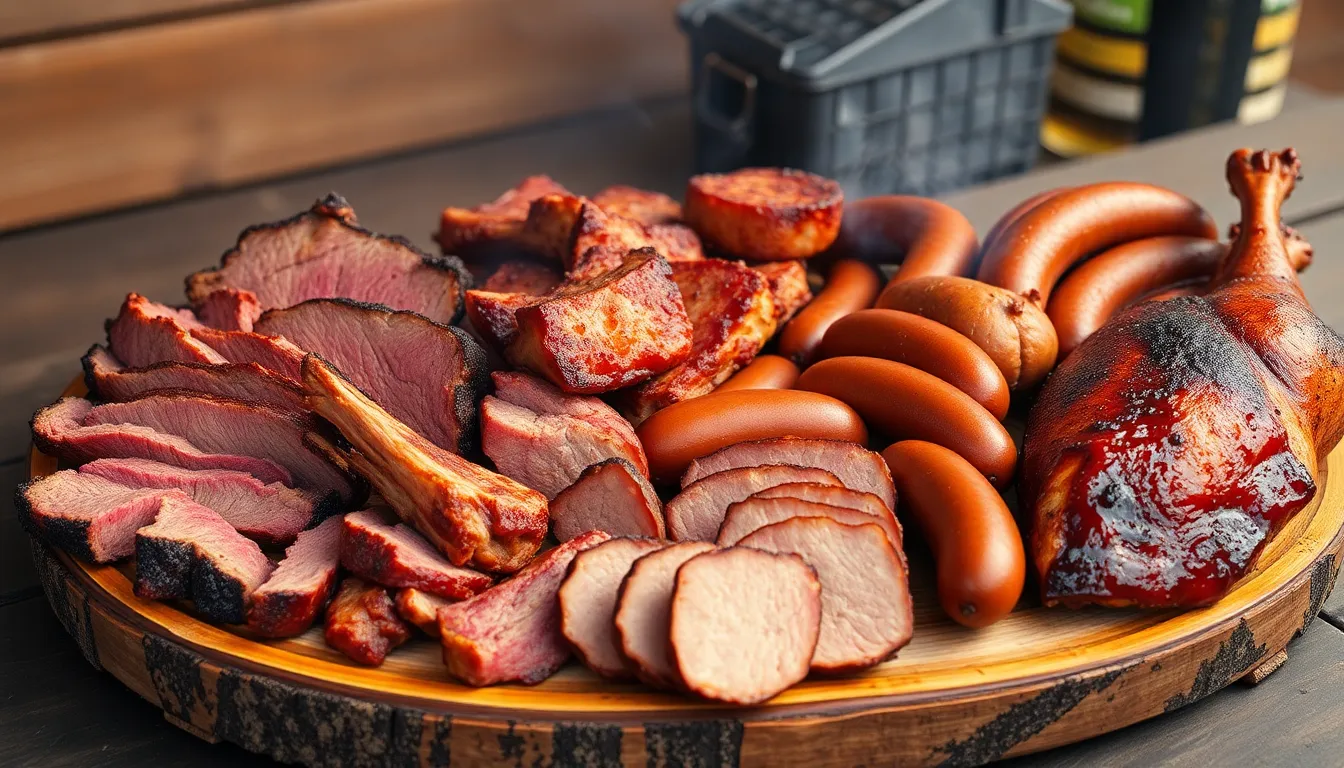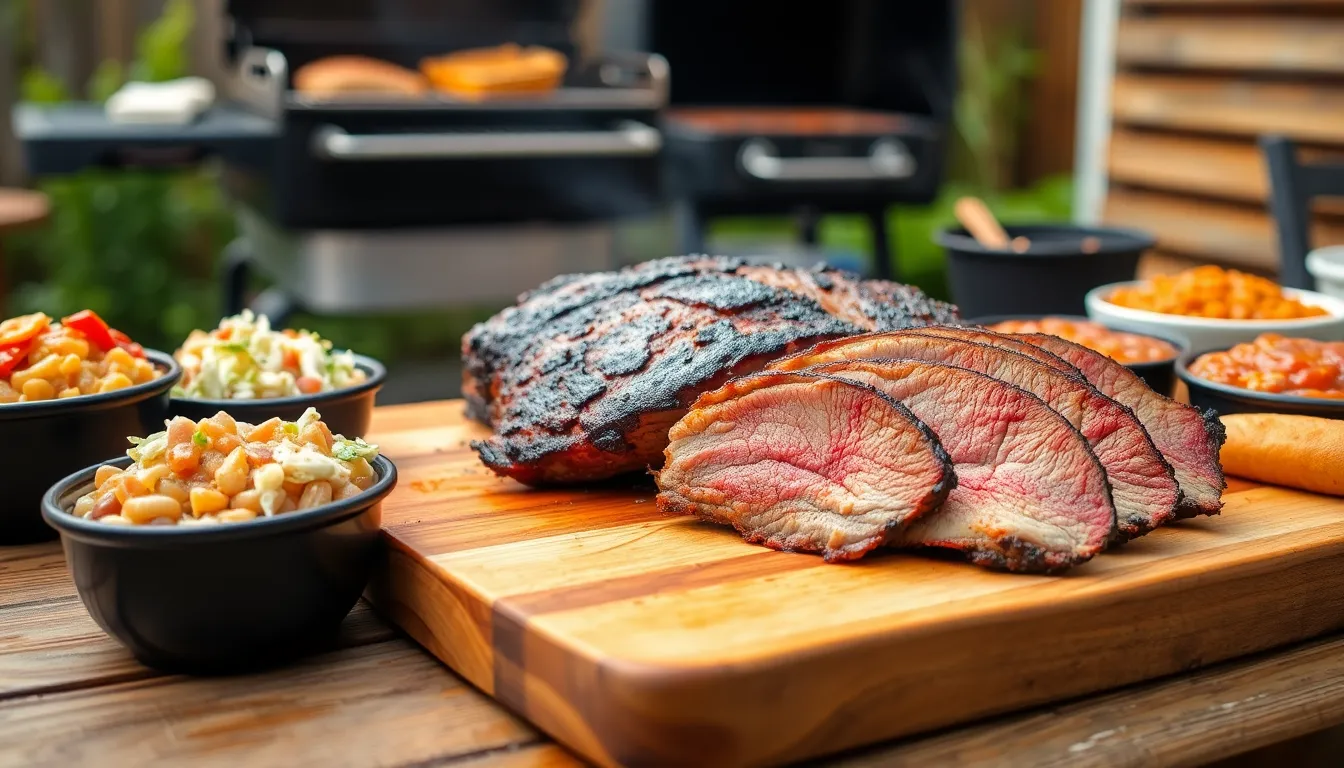Imagine sinking your teeth into a tender, smoky brisket that practically melts in your mouth. Smoked meats aren’t just food; they’re an experience that elevates any meal from ordinary to extraordinary. Whether it’s a backyard barbecue or a cozy dinner, the rich flavors and tantalizing aromas of smoked meats have a way of bringing people together—like a culinary hug that says, “You’re welcome here.”
Table of Contents
ToggleOverview of Smoked Meats
Smoked meats come from a variety of cuts, each providing a unique flavor and texture. Common options include brisket, ribs, pork shoulder, and turkey. These meats undergo a smoking process that infuses them with rich flavors while tenderizing the meat.
Brisket, a favorite among barbecue enthusiasts, benefits from low-and-slow cooking methods. Generally, it requires around 12 to 18 hours in a smoker at temperatures between 225°F and 250°F. After smoking, the result is a tender, flavorful dish that complements any gathering.
Ribs, whether pork or beef, develop a satisfying texture when smoked. When cooked for approximately 5 to 6 hours, people often enjoy the smoky flavor combined with a sticky barbecue sauce. The balance of meat and fat in ribs enhances overall taste and mouthfeel.
Pork shoulder, known for its excellent marbling, transforms into pulled pork when smoked properly. Cooked for 10 to 14 hours at similar temperatures to brisket, this cut is perfect for sandwiches and tacos. Its versatility makes it a favorite in both casual and festive settings.
Turkey also benefits from smoking, providing a juicy alternative during holiday meals. When smoked for several hours at 225°F to 250°F, turkey retains moisture while developing a rich flavor profile. Consider adding herbs or spices for an extra layer of taste.
Each type of smoked meat offers distinct advantages and flavors. Enthusiasts often experiment with various woods, such as hickory, mesquite, and applewood, to enhance the overall experience. Smoky aromas fill the air while cooking, creating an inviting atmosphere that draws people together.
Types of Smoked Meats

Smoked meats come in various types, each with its distinct flavors and cooking methods. The following sections explore popular options that enhance meals and gatherings.
Beef Brisket
Beef brisket stands out as a favorite among barbecue lovers. It requires 12 to 18 hours of slow smoking, resulting in tender, juicy meat. The low-and-slow cooking method allows the collagen to break down, enhancing its rich flavor. Many enthusiasts apply spice rubs or marinades before smoking to create a flavorful crust. This cut tastes fantastic when served sliced alongside classic sides like coleslaw or baked beans.
Pork Ribs
Pork ribs offer a mouthwatering experience with their satisfying texture and intense flavor. Typically, a smoking time of 5 to 6 hours ensures they become tender and succulent. Various styles of ribs, such as baby backs and spare ribs, can be seasoned with dry rubs or slathered in barbecue sauce. Smoke infuses these meats, complementing their natural sweetness. Served with pickles or cornbread, pork ribs delight at any barbecue.
Smoked Sausage
Smoked sausage provides a convenient yet flavorful option for gatherings. A variety of meats, such as pork or beef, are combined with spices and herbs before smoking. Cooking times vary but usually range from 2 to 4 hours. The smoking process enhances the juiciness and richness of the sausage while developing a smoky aroma. Whether grilled or served in a sandwich, smoked sausage adds a delightful twist to any meal.
Poultry
Poultry, including chicken and turkey, remains a popular choice for smoking. Each bird can marinate overnight for added flavor. Smoking takes approximately 4 to 6 hours for chicken and around 6 to 8 hours for turkey. The results are juicy, flavorful meats perfect for serving with a variety of sides. Adding wood chips like apple or hickory enhances the taste further. Smoked poultry makes an inviting centerpiece for any feast.
The Smoking Process
The smoking process requires careful attention to detail. Different techniques yield unique flavors and textures.
Different Smoking Techniques
Some enthusiasts choose the traditional offset smoker for a classic approach. Electric smokers offer an easy, convenient option that maintains consistent temperatures. Pellet smokers use wood pellets to create an efficient heat source and provide flavorful smoke. Combined methods, such as starting with direct heat, can enhance flavor profiles, followed by transitioning to indirect heat for slow cooking. Experimenting with these techniques allows for customization, making it possible to achieve the desired taste and texture for each type of meat.
Wood Types and Their Flavors
Hickory provides a strong, smoky flavor, perfect for enriching meats like ribs and brisket. Mesquite gives a bold and intense smoke, ideal for beef but can overshadow more delicate meats. Applewood offers a mild, sweet flavor that enhances poultry and pork, making it a popular choice for those seeking a lighter touch. Cherry wood adds a subtle sweetness and attractive color, enhancing both the appearance and taste of smoked meats. Exploring various wood types contributes significantly to the overall flavor experience, inviting creativity into the smoking process.
Health Considerations
Enjoying smoked meats certainly brings culinary delight; however, considering health aspects remains important. Various factors contribute to the overall nutritional impact of these flavorful dishes.
Nutritional Profile
Smoked meats typically contain protein, essential for muscle growth and repair. For instance, a 3-ounce serving of smoked brisket provides approximately 23 grams of protein. Rich in vitamins such as B12 and niacin, these meats support energy metabolism. Iron content in smoked meats, especially in beef, aids in oxygen transport. While delicious, they also contain fats, with brisket averaging around 25 grams per serving, including both saturated and unsaturated fats. Moderation remains key when incorporating smoked meats into a balanced diet.
Potential Risks
Smoked meats pose potential health risks due to their preparation and preservation methods. Often, these items contain nitrates and nitrites, used as preservatives that may convert to harmful compounds during cooking. Consumption of processed meats, including smoked varieties, often correlates with increased colorectal cancer risks, according to studies from the World Health Organization. Additionally, high sodium content, averaging 800 milligrams per serving, raises concerns for individuals managing hypertension or cardiovascular issues. Maintaining a balanced diet with plenty of vegetables and fruits helps mitigate these risks associated with smoked meats.
Pairing Smoked Meats
Pairing smoked meats with complementary sides and beverages enhances the overall dining experience. Thoughtful combinations elevate flavors and create a satisfying meal.
Best Side Dishes
Classic side dishes shine alongside smoked meats. Coleslaw provides a refreshing crunch, balancing the richness of meats. Baked beans complement smoke with their sweet and savory flavor. Cornbread offers a hearty, slightly sweet contrast perfect for soaking up sauce. Grilled vegetables add vibrant color and nutrients, enhancing the plate visually and nutritionally. Potato salad, creamy and cool, serves as another favorite that pairs well with smoky flavors. Each side enriches the meal, bringing different textures and tastes to the table.
Ideal Beverage Pairings
Beverages play a crucial role in enhancing smoked meats. Light beers such as pilsners and lagers cleanse the palate between bites. Dark ales provide a richer flavor that pairs nicely with hearty meats. For wine lovers, a bold red, like Zinfandel or Cabernet Sauvignon, complements deep smoke flavors. Complementing the meal, iced tea offers a refreshing non-alcoholic option. Cocktails, such as whiskey sours, balance smoky profiles with bright citrus notes. Each drink choice adds another layer of enjoyment to the pairing experience.
Smoked meats have a unique ability to elevate any meal into a cherished occasion. Their rich flavors and inviting aromas create a sense of community that brings people together. Whether it’s the tender brisket or flavorful ribs each cut has its own story and charm.
The versatility of smoked meats allows for endless culinary creativity from experimenting with different wood types to pairing with sides and beverages. While enjoying these delicious dishes it’s essential to balance indulgence with health considerations.
With the right techniques and a touch of passion anyone can master the art of smoking meats and create unforgettable dining experiences.




